Family : Lutjanidae

Text © Giuseppe Mazza

English translation by Mario Beltramini
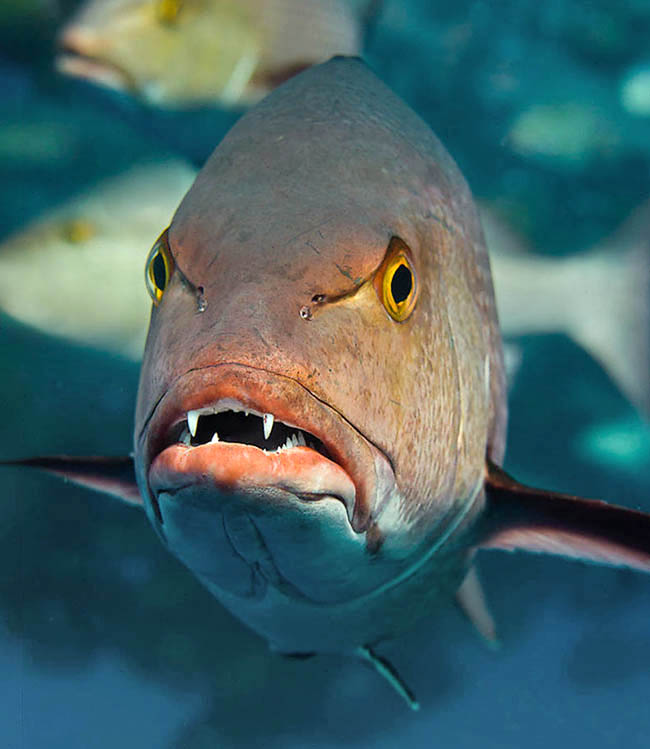
Due to its showy protruding vampire-like canines, the Two-spot red snapper is called in French Vivaneau chien rouge © Julian Cohen
Known as Two-spot red snapper due to its protruding canines and the colour of the livery, but also as White-spotted red snapper due to the two characteristic white-silvery spots on the back of the juveniles and the subadults,
Lutjanus bohar (Forsskål, 1775) belongs to the class of the Actinopterygii, the ray-finned fishes, and to the great order of the Perciformes, rich in more than 7000 species.
Actually, taxonomically, it is not a dentex.
As a matter of fact, the true ones are placed in the family of the Sparidae, whilst this belongs to the Lutjanidae.
the family of the ‘Snappers’ that presently counts 17 genera and 113 species, present in the tropical and subtropical seas of all the world.
The genus Lutjanus, created for Lutjanus lutjanus by Bloch in 1790 and today assigned to about 70 species, originates from the local Indonesian name, whilst the specific bohar comes from the Arabic “Bohár”, written also “Bhâr”, given to this fish by the Red Sea fishermen.
Zoogeography
More common around the islands than along the coasts, Lutjanus bohar covers a very vast area in the tropical Indo-Pacific.
Starting from the Red Sea and the African coasts up to South Africa, we find it, indicatively, in Madagascar, Seychelles, Maldives, India, Sri Lanka, Thailand, Singapore, Indonesia, Australia, Papua New Guinea and Solomon Islands.
Then, proceeding eastwards, after having touched south Lord Howe and north the Ryūkyū Islands south of Japan, we find it in the Fiji, Tonga and Samoa islands, and in French Polynesia with the Marquesas Islands and, finally, Pitcairn Islands.
Ecology-Habitat
Lutjanus bohar is a fish associated with the coral reefs, where it usually goes swimming between 10 and 70 m in depth, but even in deeper waters, and the adults, ageing, may go down up to about 180 m.
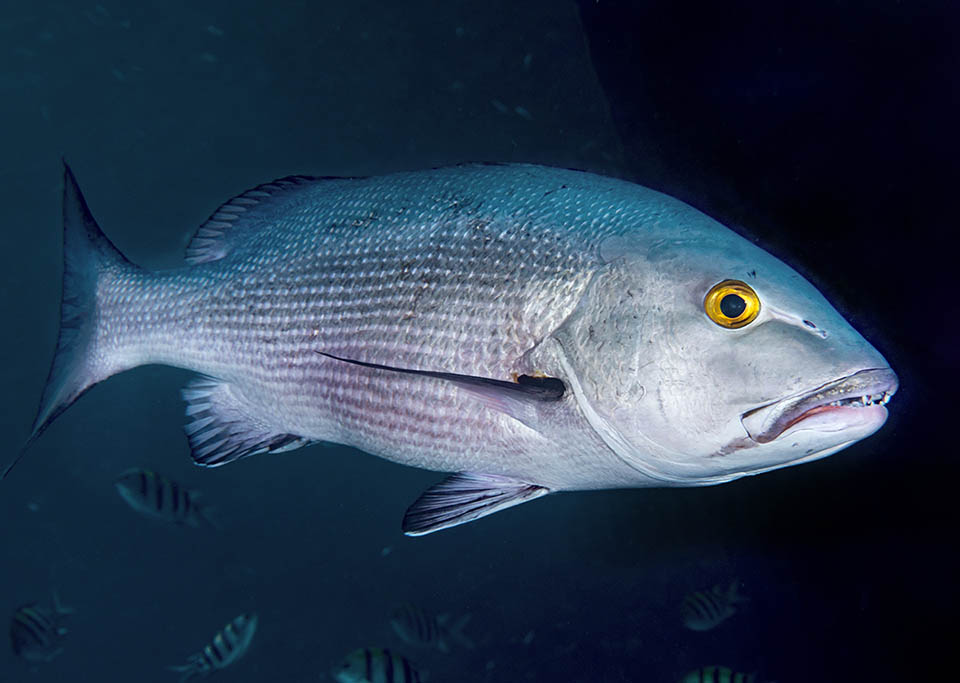
It lives in tropical Indo-Pacific where reaches the age of 55 years and 90 cm of length with a maximum weight of 12,5 kg © Rickard Zerpe
It accepts brackish waters, and the juveniles, similar to damselfishes, often grow up in the submerged prairies of phanerogams.
Morphophysiology
Though the current size is about 75 cm Lutjanus bohar can reach 90 cm, with a maximum weight of 12,5 kg.
The body, relatively tall, is reddish silver with big ctenoid overlapped scales from the clear centre forming, under the lateral line, thin horizontal lines.
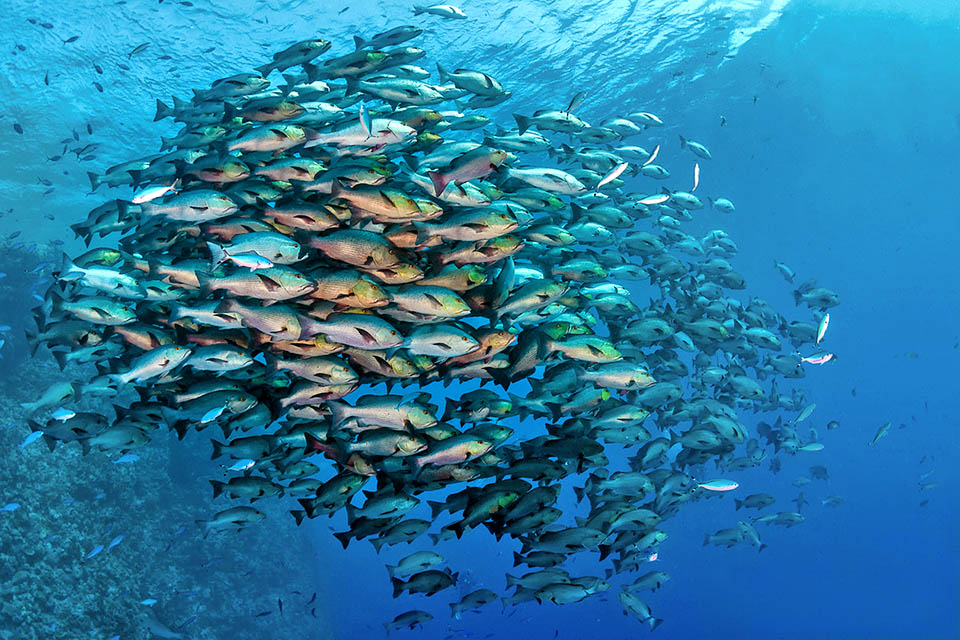
Lutjanus bohar eats mainly fishes, but also shrimps, crabs, amphipods, stomatopods, gastropods and ascidia gathering for reproduction in dense schools © David Guillemet
The body is massive with a convex profile and the snout is pointed.
The mouth displays prominent canine teeth, like a vampire, and this threatening look is emphasized by a deep oblique groove, present from the nostrils to the anterior part of the eyes. The vomerine teeth are arranged in a narrow crescent shape.
On the profile, the preoperculum displays a showy notch indentation.
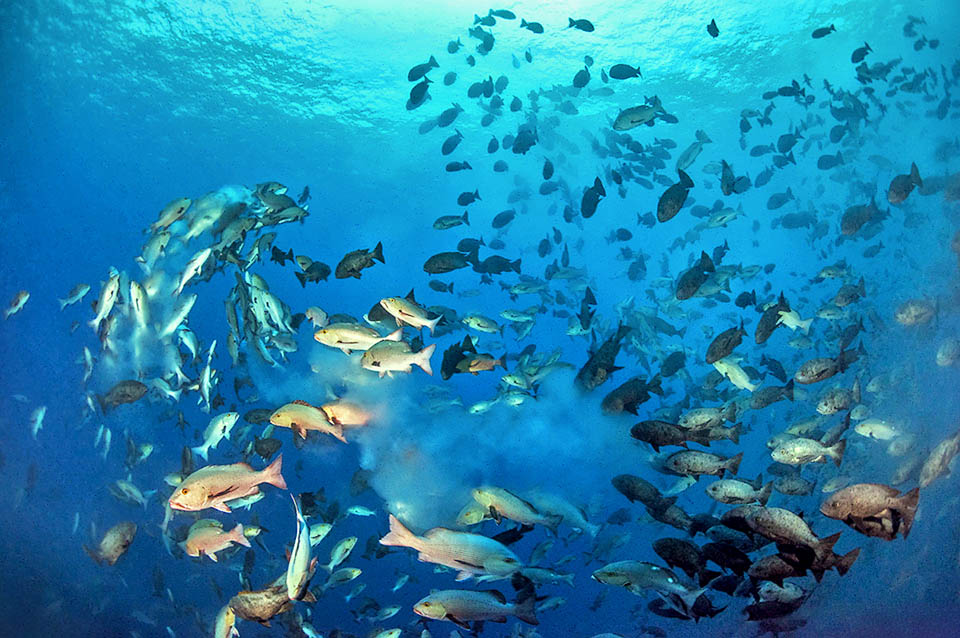
Dramatic image with clouds of sperm and eggs that are entrusted to the currents. Females reach sexual maturity only starting from 9 years of age © Richard Barnden
There is only one dorsal fin with 10 spiny and 13-14 soft rays.
The anal has 3 spiny rays and 8 unarmed. The pectoral ones, long and falcate with 16-17 rays, have pinkish hues with prominent black edges.
The pelvic ones have one spine and 5 unarmed rays. The caudal fin is more or less truncated.
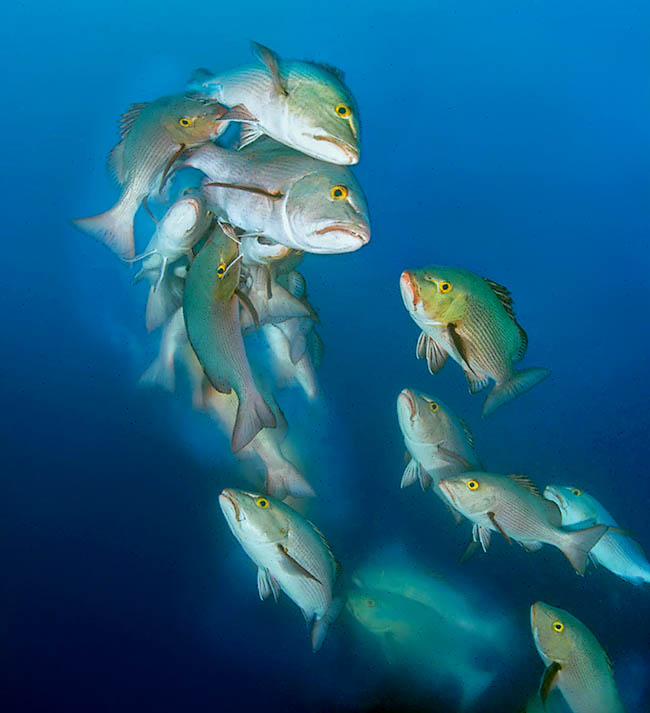
Males mature earlier, when 2, and as we note in this race for females are then often smaller © Richard Barnden
In the juveniles, besides the two aforementioned dorsal white spots, the golden iris is at times covered by a vertical black barand the caudal fin shows a dark line close to the upper margin and to the lower one.
In some locations, where the juveniles nourish of plankton mixed with Chromis iomelas, a damselfish having the livery vertically divided in two with the anterior part dark and the back white, assume instead this unusual mimetic look.
Ethology-Reproductive Biology
Growing, Lutjanus bohar then eats mainly fishes, but also invertebrates like shrimps, crabs, amphipods, stomatopods, gastropods and ascidia.
Solitary, but at times in schools of few dozen individuals, the Two-spot red snapper goes hunting mostly alone only on the steep external slopes of the reef.
It is decidedly a long-lived species that may reach the age of 55 years, but the growth is very slow with females that mature only when 9 years old, when they exceed the length of 40 cm, whilst the males are already mature when 3 years old with an average size of 30 cm.
Dense aggregations take form for the reproduction which takes place during the summer or the whole year at low latitudes.
The eggs, fecundated in groups by more males, are entrusted to the currents.
The resilience of the species is mediocre with a possible doubling of the populations in 1,4-4,4 years, and the fishing vulnerability, very high, marks 69 on a scale of 100.
As a matter of fact, Lutjanus bohar is often present, fresh or salted and dried, on the local markets, caught for consumption with nets and bottom longlines, to which we have to add the tourists’ sport fishing.
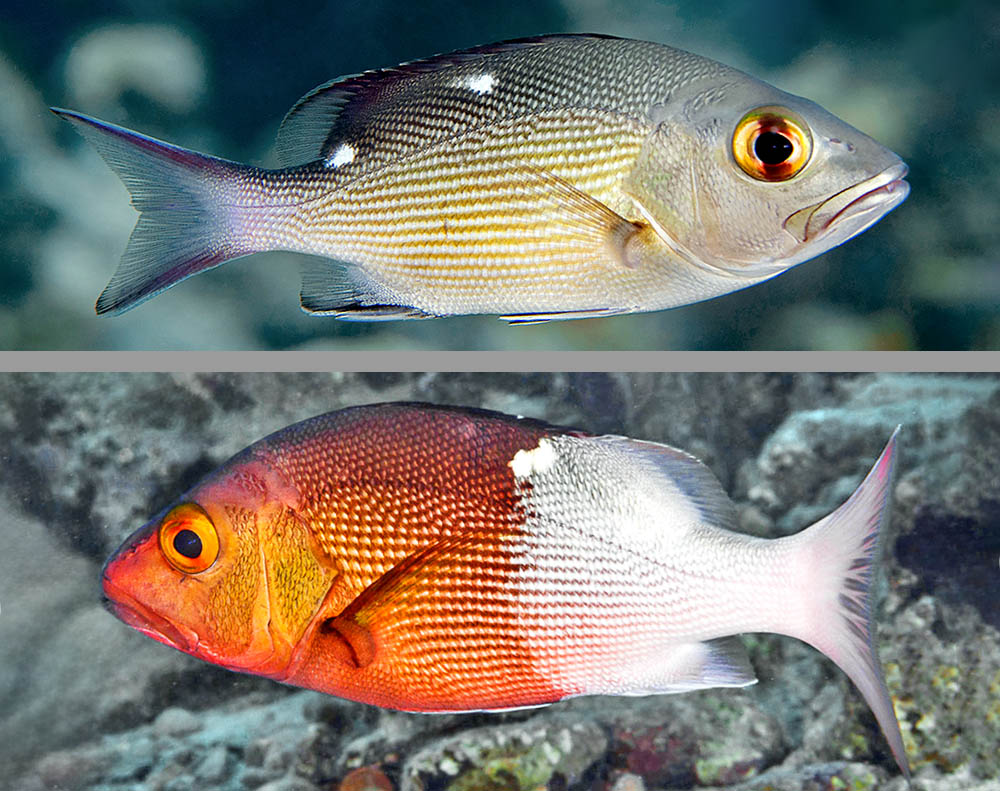
Besides the two typical dorsal white spots, that have originated also the name of Twinspot snapper, juveniles often show on the yellow iris a black vertical bar, and when they eat plankton mixed with Chromis iomelas they get the unusual bicoloured mimetic livery of these damselfishes © Rafi Amar (up) and © François Libert (below)
To give an idea of the importance of the catches, in the statistics of the year 2000 at the Seychelles it appeared at the fifth place of the fished species, with 2875 tons.
However, it must be kept in mind that in some sites, especially in the western Pacific islands, its flesh is often toxic, at risk of ciguatera, a serious food poisoning, that occurs when these fishes have been preying for years organisms that accumulate in their tissues the toxin produced by the dinoflagellate Gambierdiscus toxicus.
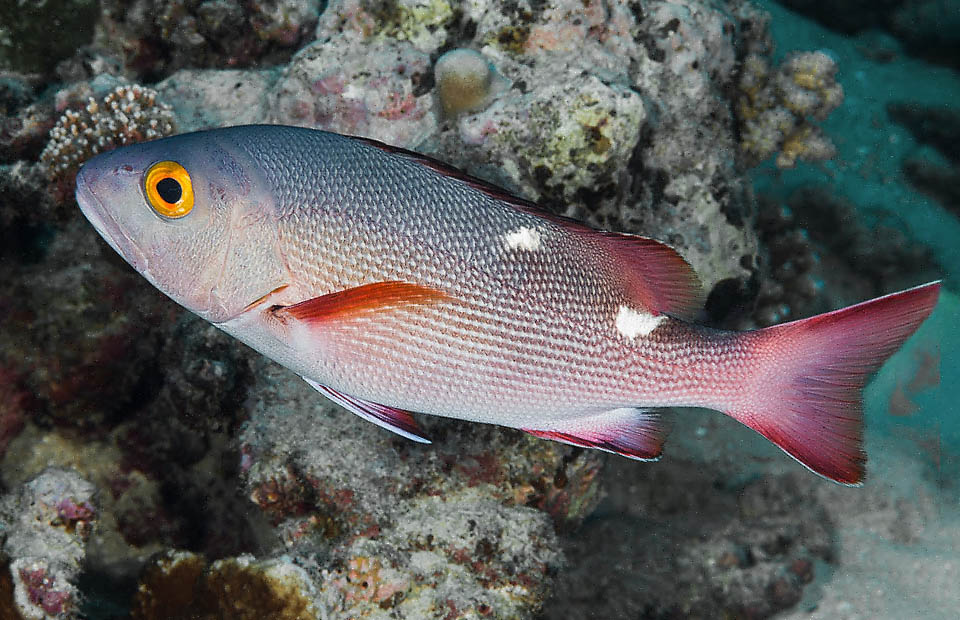
Subadult. Are still present the two white-silvery spots on the back. Lutjanus bohar is much fished but in some locations it’s at ciguatera risk © François Libert
The overfishing, linked to the late sexual maturity of the females, is the main risk factor for Lutjanus bohar, but, considered the vast diffusion, it however appears since 2015 as “LC, Least Concern”, that is at “Minimal Worry” in the IUCN Red List of the endangered species.
Synonyms
Sciaena bohar Forsskål, 1775; Sparus lepisurus Lacepède, 1802; Diacope quadriguttata Cuvier, 1828; Mesoprion rangus Cuvier, 1828; Lutjanus rangus (Cuvier, 1828); Diacope labuan Montrouzier, 1857; Mesoprion rubens Macleay, 1882; Lutianus nukuhivae Seale, 1906; Lutjanus coatesi Whitley, 1934.
→ For general information about FISH please click here.
→ For general information about BONY FISH please click here
→ For general information about CARTILAGINOUS FISH please click here.
→ To appreciate the BIODIVERSITY of BONY FISH please click here.
→ To appreciate the BIODIVERSITY of CARTILAGINOUS FISH please click here.
